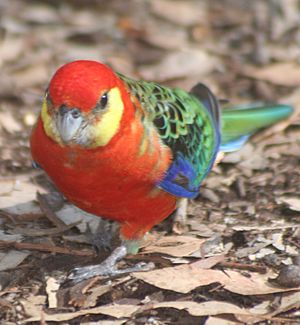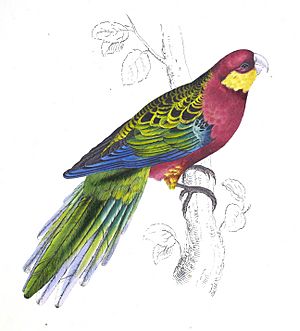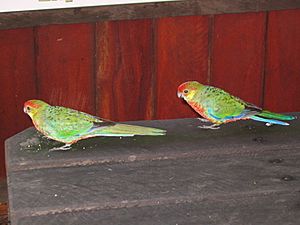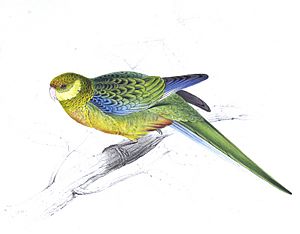Western rosella facts for kids
Quick facts for kids Western rosella |
|
|---|---|
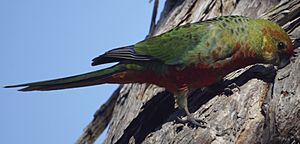 |
|
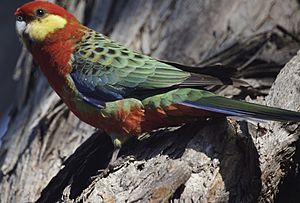 |
|
| Conservation status | |
| Scientific classification | |
| Genus: |
Platycercus
|
| Species: |
icterotis
|
The western rosella (Platycercus icterotis), also called the moyadong, is a colorful parrot. It lives only in southern Western Australia. This bird has a bright red head and belly. Its back is a mix of black, red, green, and buff colors. A yellow patch on its cheek helps you tell it apart from other rosellas.
Male and female western rosellas look a bit different. Males are brighter red. Females have duller colors. Young birds don't have the strong colors of adult birds. Their calls are soft pink-pink sounds. They are usually quiet and hard to spot. They live in eucalypt forests. You might see them when they come out to eat seeds in open areas.
Western rosellas usually stay in pairs. They live in one area. Sometimes, they join small groups if there's lots of food. They mostly eat seeds from grasses and plants. They also sometimes eat nectar and insect larvae. In the past, they were seen as pests because they ate farm crops. Now, they are protected.
These rosellas are calmer and friendlier than other rosellas in Australia. They are popular as pet birds around the world. People started keeping them as pets in the 1830s in England. They were first successfully bred in captivity in the early 1900s.
There are two main types, or subspecies, of western rosellas. One lives inland in farming areas. The other lives near the coast in different types of woodlands. These two groups meet in an area with less rain. Here, they sometimes breed together.
Contents
About the Western Rosella
The western rosella is the smallest type of rosella. An adult bird weighs about 60 to 70 grams. It is about 25 to 30 centimeters long. Its wingspan is about 35 to 41 centimeters. Its tail is long, about 13 centimeters.
Male and female western rosellas look different. This is called sexual dimorphism. The male's red feathers are a brighter scarlet. The female's red feathers are duller. They are often mixed with green. Females also have a smaller, duller yellow cheek patch.
Appearance of Males
Adult male western rosellas have mostly red heads and necks. They have a bright yellow cheek patch. This patch is pale cream in the inland subspecies. Their red feathers have black edges when they are new. Their backs have black feathers mixed with red, green, and buff.
Their folded wings are green. The shoulder feathers are black with green edges. They have a small dark blue patch on their shoulders. The blue of their flight feathers shows when they fly. Their upper tail feathers are green. The central tail feathers are blue and green. The outer tail feathers are blue with white tips. Their bellies are red with green sides.
The beak is pale blue-grey. The legs and feet are slate grey. Their eyes are dark brown.
Appearance of Females
In adult females, most of the red on the head, neck, and belly is replaced by green. They have a solid red band across their forehead. The yellow cheek patch is smaller. Females do not have red feathers on their backs. Females also have a wide white or cream stripe under their wings.
Appearance of Young Birds
Young western rosellas look like adult females. But they have even more green feathers. They only have red on the top of their heads. They don't have a yellow cheek patch at all. Their beaks are light pink. They change to adult colors by about six months old.
Vocalizations
The western rosella makes soft, musical calls. These calls are usually quiet. Other types of rosellas in different areas are much louder. Their calls are often heard in noisy exchanges with other birds. The western rosella's contact call is similar to the mulga parrot's call, but louder.
Where Western Rosellas Live
The western rosella lives only in the southwest of Australia. It is separate from other rosella types in the north and east. It is fairly common and usually stays in one place. It lives in forests, woodlands, and open areas called kwongan. You can also see them on farms or in other places where they can find food. They are often seen in areas where trees have been cleared.
The two subspecies live next to each other. P. icterotis xanthogenys lives inland in the wheatbelt region. P. icterotis icterotis lives in coastal areas. The border between them runs from the Swan River to the Arrowsmith River on the coast. Then it goes east and south past Southern Cross, Esperance, and Kojonup.
The number of western rosellas has gone down a lot since people settled in Australia. This is especially true for the inland subspecies after the 1970s. They have disappeared from some areas where they used to live. This is because their habitat has been removed. They haven't adapted to farm crops as well as some other parrots. This has made it harder for them to move into new areas.
They like woodlands with sheoak and eucalypt trees like wurak and wandoo. But they have also done well in some farm areas. They can be seen on roadsides, golf courses, and nature reserves. Here, they eat grasses and weeds. The coastal subspecies lives in areas with high rainfall. They are found among marri, karri, moitch, and paperbark trees. They eat fruits, flowers, and seeds from these plants.
The inland subspecies lives in drier, wooded scrub areas. These include moitch, wandoo, wurak, and mallee trees. They eat seeds from wandoo and acacia trees. They also eat flowers from other plants.
Behavior
Western rosellas usually hang out in pairs. But they can gather in groups of about twenty to find food. Sometimes, groups can be as large as twenty-six birds. They are very discreet. They often stay hidden when they eat on the ground or rest in thick tree leaves. They usually stay in one place. But they might travel to places with lots of food.
When they are eating in the open, they are not usually scared of people. You can often get quite close to them. They walk easily and fly in a wavy pattern. Their flight is lighter than other larger rosella species.
Reproduction
Scientists haven't studied the breeding habits of the western rosella very much. Females start going into nesting holes in July. Males join them from mid-August. Eggs are laid from late August to late September. They hatch from late September to late October. Young birds leave the nest from late October to mid-November.
Western rosellas nest in hollows and spout-shaped holes in trees. They prefer large, old eucalypt trees. Karri and wandoo trees are often chosen. They also use holes in tree stumps and fence posts. The hollows are usually about a meter deep. They prefer hollows with dust from insects at the bottom. The eggs are laid directly on this dust or debris. The nest is not decorated.
Usually, one group of young birds is raised each breeding season. But in captivity, they often raise two groups. A female lays between two and seven eggs, sometimes nine. The eggs are oval-shaped and about 22 by 26 millimeters. Only the female sits on the eggs. The male stays nearby and brings her food.
The eggs hatch after 23 to 25 days. The young birds leave the nest about five weeks later. Young birds have yellowish beaks. They have pale grey downy feathers when they hatch. About 72% of eggs survive to become independent birds.
Feeding Habits
Western rosellas mainly eat seeds. They often eat seeds from introduced weeds and farm crops. But they also eat seeds from native eucalypt and sheoak trees. They also eat nectar and insects, especially when they are breeding and feeding their young. They eat seeds from plants like capeweed, thistles, and clover.
They are not very cautious in rural areas. They pick up seeds in fields after harvests. They even go inside buildings and animal pens. Early reports from settlers said these birds would visit farms for seeds and soft fruit. They were not afraid of people. They cause very little damage to crops. They seem to eat fruit that is already damaged by other parrots. They mostly look for seeds near flower crops.
Conservation Status
In 1921, the western rosella was called a "vermin" (pest) by the Western Australian government. This was because people thought they harmed farms. They were considered a pest until 1998. Then, they were declared a 'protected native species'. It became illegal to kill them. The government now warns people about harming them. They offer advice and licenses for using non-deadly ways to keep them away.
The inland subspecies, P. icterotis xanthogenys, is considered "likely to become extinct." In 2000, it was listed as 'near threatened'. However, the International Union for the Conservation of Nature (IUCN) listed the species as a whole as a "species of least concern" in 2013. They noted that the species has become less common and disappeared from some areas. This is due to habitat loss. Like most parrots, the western rosella is protected by CITES. This means it's illegal to import, export, or trade wild-caught birds.
Western Rosellas as Pets
Western rosellas are popular birds for aviaries and zoos. They are known for being calm and not as noisy as other rosellas. In Australia, their status as a pet bird is considered secure.
These birds can breed when they are one year old. Females can lay up to two groups of eggs. Because they are calm and reproduce well, their numbers in captivity have grown. One male bird was reported to have fathered 27 young over four seasons when he was 12 years old.
It's easy to tell male and female western rosellas apart by their colors. This is not always true for other rosellas. They also have a unique way of scratching their heads. They arch their foot behind and over their wing. Female western rosellas keep the stripe under their wings that young birds have. This stripe disappears in males.
Nesting boxes in aviaries need to be strong. These birds like to chew on logs. These logs can also provide hollows for laying eggs. The breeding season is from September to January. Females lay four to five eggs. The eggs hatch in about twenty days. The young birds leave the nest about twenty-five days after hatching. They get their full adult feathers at about fourteen months old.
Western rosellas were kept in aviaries and zoos in the 1800s. By the early 1900s, people started successfully breeding them. The first record of breeding in England was in 1908. The species became less common in England in the 1950s.
See also
 In Spanish: Perico carigualdo para niños
In Spanish: Perico carigualdo para niños



